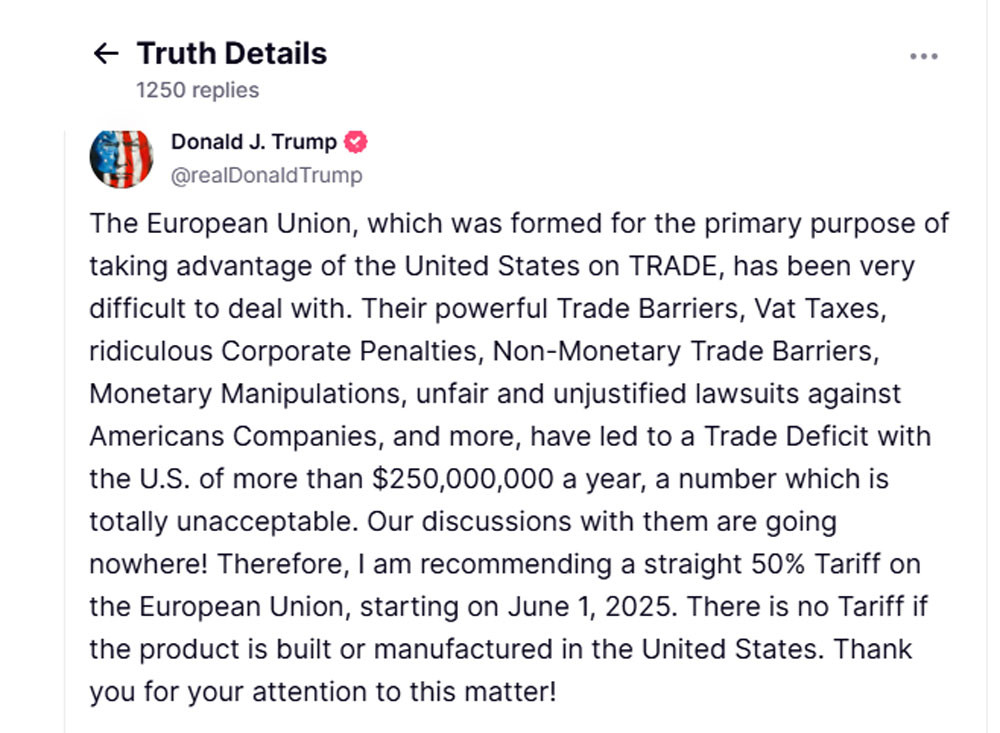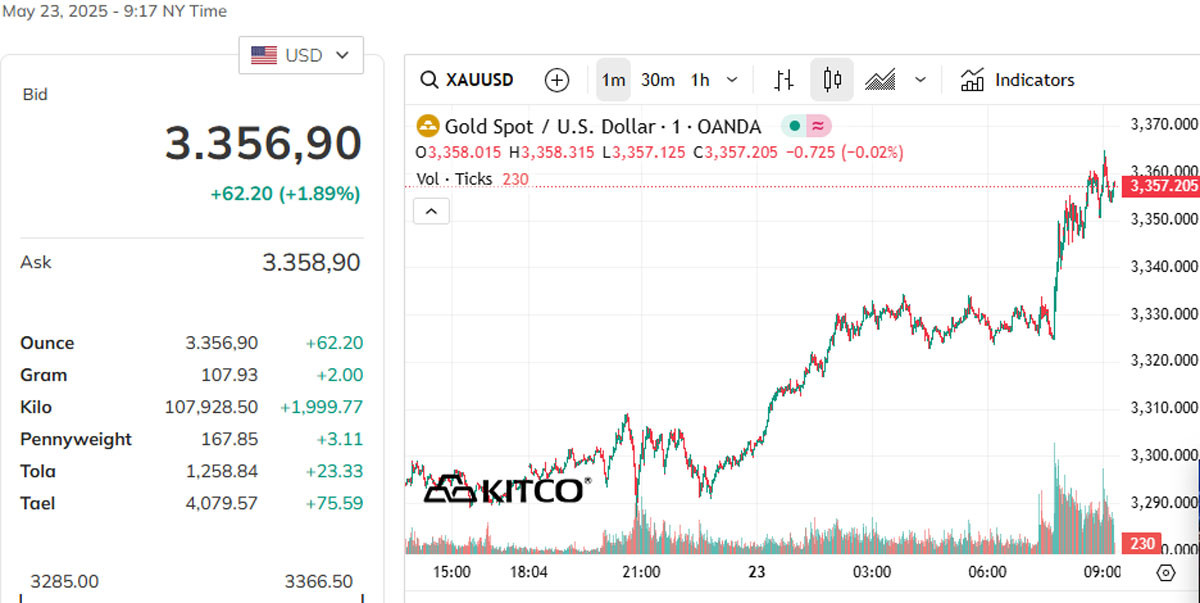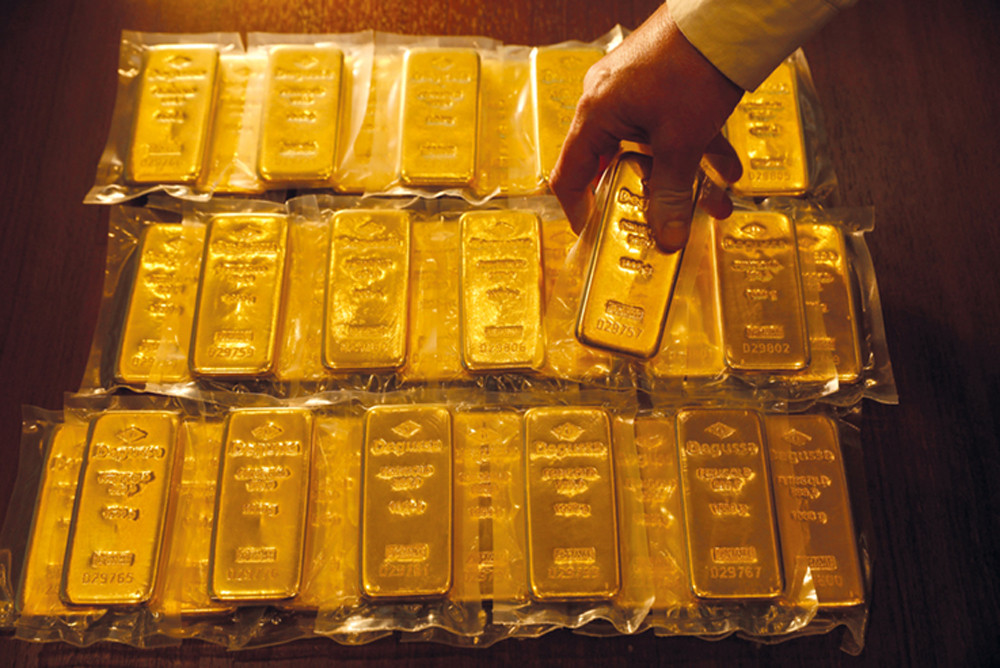Gold prices soar, USD plunges amid Trump storm
At the beginning of the trading session on May 23 on the New York market (evening of May 23, Vietnam time), the US financial market witnessed strong fluctuations after US President Donald Trump posted on TruthSocial, criticizing the European Union (EU) for trade barriers and threatening to impose a 50% tax on EU goods from June 1.
At the same time, Mr. Trump also put pressure on Apple, asking the corporation to move iPhone production to the US, otherwise it would be subject to a 25% tax on imported products. These statements immediately shook the market, pushing the price of gold up more than 50 USD/ounce, reaching 3,350 USD/ounce at the opening session in New York.
The escalation of trade tensions has stimulated demand for gold, which is considered a safe haven asset amid economic and geopolitical uncertainty. Fears of rising inflation have also boosted gold prices.
Meanwhile, the US dollar was under pressure, with the DXY index falling 0.6% to 99.3. The decline was partly due to investor concerns that Mr. Trump’s tariff policies could worsen the US fiscal deficit, especially after the 30-year Treasury yield jumped to 5.09%/year and the 10-year yield reached 4.59%. Bond yields rose sharply due to concerns about the new budget bill, which could increase public debt and inflation.

The US stock market was also hit hard. Apple shares fell more than 2% in pre-market trading on May 23 after Trump’s announcement. US stocks had previously suffered sharp declines.
US-EU trade talks deadlocked, tariffs threaten inflation
The trade talks between the US and the EU are at a standstill, despite efforts from both sides. On May 23, EU Trade Commissioner Maroš Šefčovič is scheduled to discuss with US Trade Representative Jamieson Greer a new EU proposal that includes gradually reducing tariffs on non-sensitive goods and increasing cooperation in areas such as energy and 5G and 6G networks.
However, the US side said that this proposal did not meet expectations, and Mr. Trump asked the EU to unilaterally cut tariffs on US goods to avoid an additional 20% tax.
Previously, in March, the US imposed a 25% tariff on cars, steel and aluminum from the EU, followed by a 20% tariff on other goods in April. The US then temporarily reduced this tariff to 10% for 90 days to allow the two sides to negotiate.
Trump’s latest statement on TruthSocial on the evening of May 23 (Vietnam time), threatening to impose a 50% tariff on the EU from June 1, has raised concerns about a full-blown trade war. Trump criticized the EU for trade barriers, VAT, and currency manipulation, saying the trade deficit with the EU is “unacceptable.”
Bernard Arnault, CEO of LVMH, called on the EU to be more lenient in negotiations, stressing the need for mutual concessions. However, he admitted that things were not going smoothly.

If the EU fails to meet Trump’s demands, the 50% tariffs could severely damage EU industries, especially autos, steel, and luxury goods. The EU has prepared a $108 billion retaliatory tariff package targeting items such as aircraft, cars, and medical equipment from the US, raising the risk of a trade war.
Along with the US-EU and US-China tensions, Mr. Trump continues to put pressure on American corporations, especially Apple, by asking the company to move iPhone production to the US to avoid a 25% tax. Currently, the majority of iPhones are manufactured in China, with a small portion in India. Wall Street analysts predict that moving production to the US could increase iPhone prices by at least 25%, directly affecting American consumers.

Trump’s tariffs aren’t just aimed at Apple, they could extend to other companies that rely on global supply chains. Higher tariffs, such as those estimated at 145% on Chinese goods, could disrupt supply chains and drive up import costs. That raises inflation concerns, especially as companies like Walmart say they could pass the cost of tariffs on to consumers.
According to S&P Global, the US composite manufacturing PMI rose to 52.1 in May, but production costs also increased due to supply chain issues and tariffs. This could lead to a stagflation scenario, when inflation rises while economic growth slows.
With the weakening of the US dollar, investors tend to shift money into gold, pushing up the price of the precious metal. Goldman Sachs predicts that gold prices could reach $3,700/ounce by the end of 2025, if trade tensions continue to escalate.
However, if the Trump administration reaches a trade deal with the EU and/or China, the pressure on gold could ease. However, in the short term, the uncertainty from Trump’s tariff policies continues to be the main driver of gold prices and pressure on US financial markets.
Trump’s tough statements against the EU and Apple on the evening of May 23 (Vietnam time) shook the financial markets, pushing gold prices back to a very high level and the USD plummeting. In the context of the deadlock in US-EU trade negotiations and the risk of escalating tariffs, the US market is facing inflation risks and economic instability. Gold, as a safe-haven asset, continues to be the destination for cash flows, while investors await further developments from Mr. Trump’s trade policy.

Source: https://vietnamnet.vn/ong-trump-chi-trich-eu-ra-toi-hau-thu-voi-apple-gia-vang-tang-vot-2404230.html


































































































Comment (0)